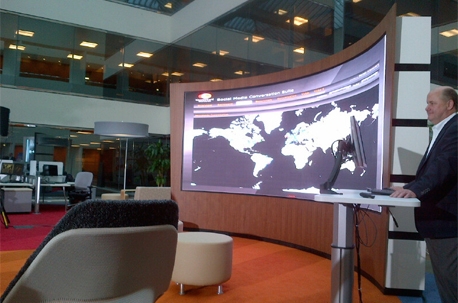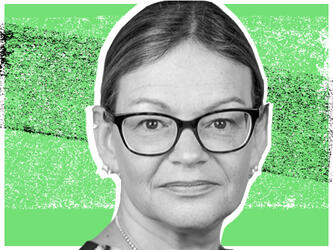Chain of command

Mastercard’s ‘social media conversation suite’. Image courtesy of Mastercard.
But more and more big businesses – Kraft, Mastercard, ASDA, to name a few – are putting social media insight at the centre of their operations. They’re doing this through their use of social media command centres: a physical room within an organisation that displays numerous screens (typically four to eight) of real-time, filtered social media data, monitored by a cross-functional team. The make up of this team can vary, but it would typically be comprised of PR, insight and marketing representatives. Nikki Carlisle (pictured), a director at Freshminds, who spoke at this week’s Social Media Week in London on the rise of these command centres, describes them as being like “Nasa ground control”.
Wells Fargo, a large US bank, has three social media command centres – two in the US and one in the Philippines, to allow for a 24/7 presence – that primarily serve a customer care function. If a customer contacts the bank via social media, it can respond quickly, because someone is always monitoring its feed. But the most effective use of these command centres goes way beyond this.
Slam dunk in the dark
“Everyone knows about the Oreo tweet produced during the Superbowl blackout,” says Carlisle. “They produced that tweet within 10 minutes and grew their Twitter followers by 8,000 within minutes.
“What’s less known is that they were able to do that because they had a social media command centre set up within their digital agency. They had all the relevant people – digital agency, media agency, ad creative and marketing people – in one place, so were able to plan, execute, sign off and implement that response within minutes.”
Another example of a timely response to Twitter activity facilitated by a social media command centre comes from US food giant Kraft, which has a large command centre room with eight screens, providing US-wide data that can be filtered by State level. The team there noticed an unexplained surge in sales of its Philadelphia cream cheese during St Patrick’s Day celebrations in the US. “It looked like an anomaly,” says Carlisle, “but through monitoring Twitter they realised it was actually because people were making something called green velvet cake, which you need Philadelphia cheese for. They realised there was an opportunity there, and it’s an example where you really needed to be there in the moment to understand what was happening.”
According to Carlisle, the benefit of command centres is not just their ability to respond quickly, but because they’re manned by a cross-discipline team, there is less chance of a potentially beneficial social media trend being overlooked. “You can see how momentum might have been lost if an analyst hadn’t seen the potential of that cream cheese trend,” she says. “It was picked up because people in the social media command centre were closer to what benefit that insight could have. Insights are useless unless they land with the right people at the right time. And the larger the organisation, the trickier it is for all insights to be given the right priority.”
Location, location, location
Carlisle also notes that you can tell a great deal about how central a command centre is to a company by the space it is given. “If you’ve been allocated the broom cupboard next to the loos, you kind of understand the importance – or not – that company has put on it.
“Mastercard has a massive screen (known as its ‘conversation suite’) right in the atrium of its headquarters. It’s a 40 foot screen. They’ve elevated social to such an extent that they’re using it as a tool to keep executives of all levels close to customers. It’s like a real-time focus group.”

We hope you enjoyed this article.
Research Live is published by MRS.
The Market Research Society (MRS) exists to promote and protect the research sector, showcasing how research delivers impact for businesses and government.
Members of MRS enjoy many benefits including tailoured policy guidance, discounts on training and conferences, and access to member-only content.
For example, there's an archive of winning case studies from over a decade of MRS Awards.
Find out more about the benefits of joining MRS here.












0 Comments